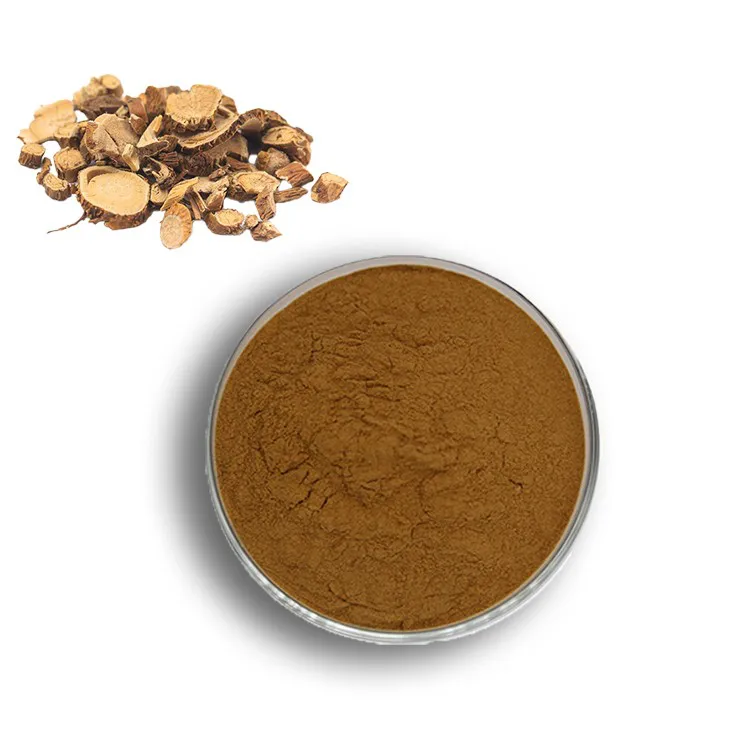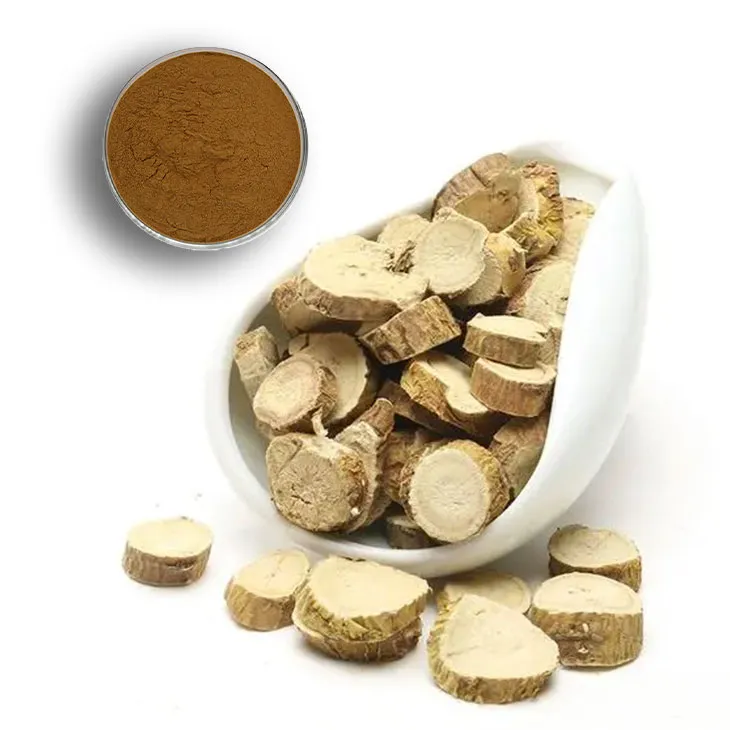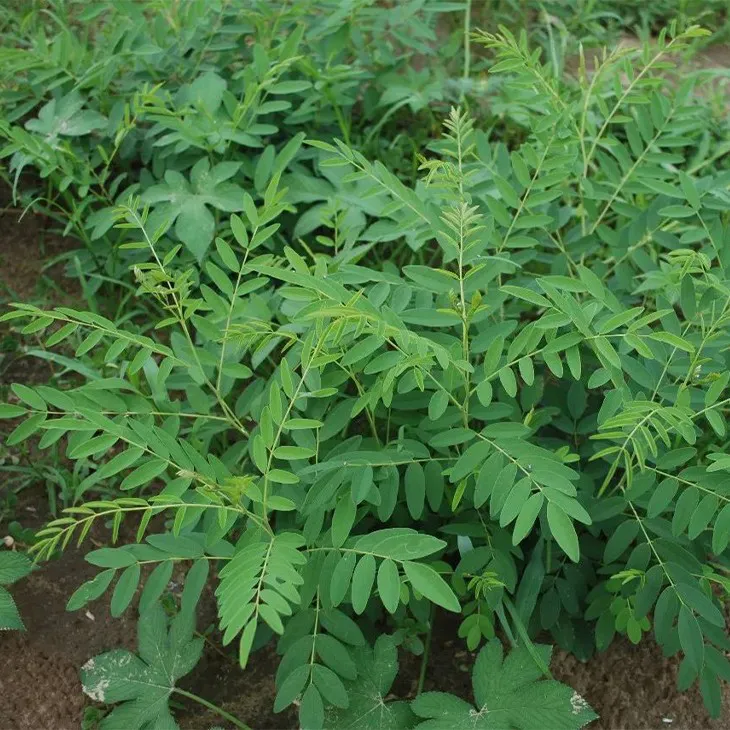- 0086-571-85302990
- sales@greenskybio.com
The Best Types of Sophora Flavescens Root Extract: A Guide to Selecting the Best Sophora Flavescens Root Extract.
2024-11-13

Introduction
Sophora flavescens root has been used in traditional medicine for centuries. The root extract of Sophora flavescens is rich in various bioactive components, making it valuable in many fields such as health, beauty, and pharmaceuticals. However, not all Sophora Flavescens Root Extracts are the same. Different extraction methods, raw material sources, and quality control measures can lead to significant differences in the quality and effectiveness of the extract. This article aims to provide a comprehensive guide to help you select the best Sophora Flavescens Root Extract for your specific needs.

1. Understanding Sophora Flavescens Root
Sophora flavescens, also known as Kushen in Chinese traditional medicine, is a perennial herbaceous plant. It is native to Asia and has a long history of medicinal use. The root of Sophora flavescens contains a variety of chemical components, including alkaloids, flavonoids, and triterpenoids. These components are believed to be responsible for its various pharmacological effects.
1.1 Alkaloids in Sophora Flavescens Root
Alkaloids are one of the most important groups of active components in Sophora flavescens root. For example, matrine and oxymatrine are two well - known alkaloids. They have been shown to have anti - inflammatory, anti - viral, and anti - tumor properties. Matrine can regulate the immune system and has potential in treating autoimmune diseases. Oxymatrine has been studied for its ability to inhibit the replication of viruses such as hepatitis B virus.
1.2 Flavonoids in Sophora Flavescens Root
Flavonoids in Sophora flavescens root also contribute to its medicinal properties. They possess antioxidant activities, which can help to scavenge free radicals in the body. This antioxidant effect is beneficial for preventing oxidative stress - related diseases, such as cardiovascular diseases and neurodegenerative disorders. Some flavonoids also have anti - allergic and anti - microbial effects.
1.3 Triterpenoids in Sophora Flavescens Root
Triterpenoids in the root play a role in anti - inflammation and immunomodulation. They can interact with the body's immune cells to enhance the immune response or regulate excessive immune reactions. Additionally, triterpenoids may have potential in anti - cancer research, as they can affect the growth and apoptosis of cancer cells.

2. Extraction Methods of Sophora Flavescens Root Extract
The extraction method used significantly impacts the quality and composition of the Sophora flavescens root extract.
2.1 Solvent Extraction
- Water extraction: Water is a common solvent for extracting Sophora flavescens root. It is a relatively simple and safe method. Water extraction can obtain water - soluble components such as some flavonoids and polysaccharides. However, the extraction efficiency for alkaloids may be lower compared to other solvents.
- Ethanol extraction: Ethanol is widely used in the extraction of Sophora flavescens root extract. Ethanol can extract a wide range of active components, including alkaloids, flavonoids, and triterpenoids. It has a relatively high extraction efficiency and can also help in the preservation of the extract due to its antimicrobial properties. The concentration of ethanol can be adjusted according to the desired components to be extracted.
- Other solvents: Some other solvents such as methanol and acetone may also be used in extraction. However, these solvents may have some toxicity issues, and extra care is needed during the extraction process to ensure the safety and quality of the final product. They are mainly used in laboratory research rather than large - scale commercial production.
2.2 Supercritical Fluid Extraction
Supercritical fluid extraction, often using carbon dioxide as the supercritical fluid, is a more advanced extraction method. It has several advantages:
- It can operate at relatively low temperatures, which helps to preserve the thermally sensitive components in the Sophora flavescens root. This is important as some active components may be degraded at high temperatures during traditional extraction methods.
- The selectivity of supercritical fluid extraction is relatively high. It can be adjusted to extract specific components more effectively. For example, it can be optimized to extract alkaloids with high purity.
- The final product obtained by supercritical fluid extraction is relatively pure and free from solvent residues, which is a significant advantage in the pharmaceutical and health - care industries.

3. Quality Control of Sophora Flavescens Root Extract
Quality control is crucial to ensure the safety and effectiveness of Sophora Flavescens root extract.
3.1 Raw Material Selection
- The origin of Sophora flavescens plants should be carefully considered. Plants grown in clean and unpolluted environments are preferred. For example, wild - harvested Sophora flavescens should come from areas without excessive pesticide use or industrial pollution.
- The age and growth conditions of the plants also affect the quality of the root. Generally, roots from mature plants with proper growth conditions are likely to have a higher content of active components.
3.2 Standardization of Active Components
- For extracts used in the pharmaceutical industry, strict standardization of active components is required. For example, the content of matrine and oxymatrine should be within a certain range to ensure consistent pharmacological effects.
- Quality control methods such as high - performance liquid chromatography (HPLC) are often used to measure and control the content of active components in the extract.
3.3 Safety and Purity
- The extract should be free from contaminants such as heavy metals, pesticides, and microbial contaminants. Regular testing for these contaminants is essential in the production process.
- During the extraction and processing, proper manufacturing practices should be followed to ensure the purity of the final product. This includes using clean equipment, proper storage conditions, and quality - assured raw materials.
4. Applications of Sophora Flavescens Root Extract
The diverse active components in Sophora flavescens root extract make it applicable in various fields.
4.1 In Health and Medicine
- Anti - inflammatory: As mentioned before, the alkaloids and triterpenoids in the extract have anti - inflammatory properties. It can be used to treat inflammatory diseases such as arthritis, where reducing inflammation can relieve pain and improve joint function.
- Anti - viral: The extract, especially due to the presence of alkaloids like oxymatrine, has shown potential in fighting viral infections. It may be used in the treatment or prevention of viral diseases such as hepatitis.
- Immune - modulating: By interacting with the immune system, the extract can enhance or regulate the immune response. This can be beneficial in both immunocompromised patients to boost their immunity and in patients with autoimmune diseases to regulate excessive immune reactions.
4.2 In the Beauty Industry
- Antioxidant: The flavonoids in the extract act as antioxidants. In beauty products, they can help to protect the skin from oxidative damage caused by free radicals. This can slow down the aging process of the skin, reduce wrinkles, and improve skin elasticity.
- Anti - acne: The anti - inflammatory and anti - microbial properties of the extract can be useful in treating acne. It can reduce inflammation in acne - prone skin and inhibit the growth of acne - causing bacteria.
5. How to Select the Best Sophora Flavescens Root Extract
When choosing the best Sophora flavescens root extract, several factors need to be considered.
5.1 Determine Your Purpose
- If you are using it for health purposes, such as treating a specific disease or improving overall immunity, you should look for an extract with a high content of relevant active components. For example, if you are targeting anti - viral effects, an extract rich in oxymatrine may be more suitable.
- For beauty applications, an extract with a high antioxidant activity, mainly due to flavonoids, may be preferred. Consider the specific skin problems you want to address, such as anti - aging or anti - acne, and select the extract accordingly.
5.2 Check the Extraction Method
- If you are concerned about the purity and quality of the extract, supercritical fluid extraction may be a better choice as it generally results in a purer product without solvent residues. However, it may also be more expensive.
- For those on a budget, ethanol extraction can be a good option as it can extract a wide range of active components effectively.
5.3 Verify Quality Control
- Look for products that have strict quality control measures in place. Check if the raw material selection is carefully done, and if the active components are standardized. For example, products with HPLC - tested active component content are more reliable.
- Ensure that the product is free from contaminants by checking for relevant test reports. This is especially important for products used in health - related applications.
Conclusion
Sophora flavescens root extract has great potential in various fields due to its rich active components. However, to fully realize its benefits, it is essential to select the best type of extract. By understanding the plant itself, the extraction methods, quality control, and applications, consumers and manufacturers can make more informed decisions when choosing Sophora flavescens root extract. Whether for health, beauty, or other purposes, a well - selected extract can ensure safety, effectiveness, and optimal results.
FAQ:
What are the main extraction methods of Sophora Flavescens root extract?
There are several common extraction methods for Sophora Flavescens root extract. One is solvent extraction, which uses solvents such as ethanol or methanol to dissolve the active components from the root. Another method is supercritical fluid extraction, which utilizes supercritical carbon dioxide. This method is often considered more environmentally friendly and can produce a relatively pure extract. Steam distillation can also be used in some cases, especially when extracting volatile components from the root.
What are the important active components in Sophora Flavescens root extract?
The Sophora Flavescens root extract contains various active components. Matrine and oxymatrine are among the most important ones. These alkaloids have been studied for their potential pharmacological properties, such as anti - inflammatory, anti - microbial, and anti - tumor activities. Flavonoids are also present in the extract, which may contribute to antioxidant effects. Additionally, there are other components like saponins that play different roles in potential health - promoting or functional applications.
How can Sophora Flavescens root extract be used in health applications?
In health applications, Sophora Flavescens root extract can be used in multiple ways. Due to its anti - inflammatory properties, it may be beneficial for treating certain inflammatory diseases, perhaps in the form of herbal supplements. Some studies suggest that its anti - microbial activity could potentially be used in the development of new antimicrobial agents. For skin health, it might be used in topical products for conditions like eczema or acne, as it may help reduce inflammation and inhibit the growth of relevant pathogens.
What are the differences between different grades of Sophora Flavescens root extract?
Different grades of Sophora Flavescens root extract can vary in several aspects. Higher - grade extracts typically have a higher concentration of active components. They may also be purer, with fewer impurities. Lower - grade extracts may contain more residual solvents or other unwanted substances. The extraction process and raw material quality also play a role in determining the grade. For example, extracts obtained through more precise and advanced extraction methods and from high - quality Sophora Flavescens roots are more likely to be of a higher grade.
How to ensure the quality of Sophora Flavescens root extract?
To ensure the quality of Sophora Flavescens root extract, several factors need to be considered. Firstly, the source of the raw material should be reliable, preferably from well - managed and sustainable plantations. Secondly, the extraction process should be carried out under strict quality control. This includes proper handling of solvents, accurate control of extraction parameters such as temperature and pressure, and appropriate purification steps. Thirdly, the final product should be tested for the content of active components, purity, and absence of contaminants. Standardized testing methods, such as high - performance liquid chromatography (HPLC) for analyzing active component levels, should be used.
Related literature
- The Pharmacological Properties of Sophora Flavescens Root Extract"
- "Analysis of Active Components in Sophora Flavescens Root: A Review"
- "Sophora Flavescens Root Extract in Cosmetic Applications"
- ▶ Hesperidin
- ▶ citrus bioflavonoids
- ▶ plant extract
- ▶ lycopene
- ▶ Diosmin
- ▶ Grape seed extract
- ▶ Sea buckthorn Juice Powder
- ▶ Beetroot powder
- ▶ Hops Extract
- ▶ Artichoke Extract
- ▶ Reishi mushroom extract
- ▶ Astaxanthin
- ▶ Green Tea Extract
- ▶ Curcumin Extract
- ▶ Horse Chestnut Extract
- ▶ Other Problems
- ▶ Boswellia Serrata Extract
- ▶ Resveratrol Extract
- ▶ Marigold Extract
- ▶ Grape Leaf Extract
- ▶ blog3
-
High purity olive leaf extract
2024-11-13
-
Lavender oil extraction method
2024-11-13
-
100% organic virgin sea buckthorn fruit oil
2024-11-13
-
Lotus leaf extract powder factory in China
2024-11-13
-
China aged garlic extract supplier
2024-11-13
-
Deer antler extract powder manufacturer
2024-11-13
-
Saw palmetto extract vs whole herb
2024-11-13
-
Propolis Extract Powder
2024-11-13
-
Angelica sinensis extract
2024-11-13
-
Rose Hip Extract
2024-11-13
-
Lemon Juice Powder
2024-11-13
-
Horse Chestnut Extract
2024-11-13
-
Reishi mushroom extract
2024-11-13
-
Honeysuckle Pollen
2024-11-13
-
Giant Knotweed Extract
2024-11-13
-
Nettle Root Extract
2024-11-13
-
Cocoa Extract
2024-11-13





















